Natural preservatives can dramatically extend your homemade fragrance's shelf life while keeping it chemical-free. You'll find powerful plant-based options in glycerin (up to 50% concentration), vitamin E oil, rosemary extract (0.02-0.4%), neem oil, grapefruit seed extract (0.1-1.0%), benzoin resin, raw honey (10-18%), tea tree oil, witch hazel, and beeswax. Each preservative offers unique benefits, from antioxidant properties to antimicrobial protection. Discover how these natural ingredients can transform your fragrance-making journey.
The Power of Glycerin in Natural Perfume Preservation
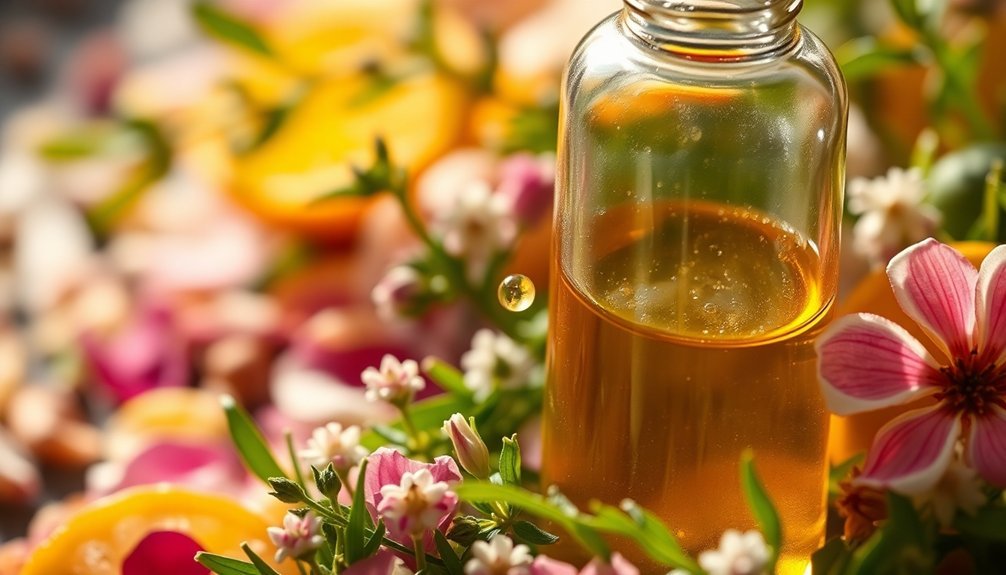
While many natural preservatives exist for homemade fragrances, glycerin stands out as a versatile option that offers both preservation and stability benefits. Its sweet clear liquid nature makes it easy to work with in fragrance formulations.
You'll find this natural compound particularly effective when used in concentrations up to 50%, as it creates an environment that discourages microbial growth through its moisture-retaining properties.
When you're crafting your natural perfumes, you can rely on glycerin's non-toxic nature and USDA-approved safety profile.
It's derived from vegetable fats like coconut or palm oils, making it an excellent choice for organic formulations.
To maximize its preservative power, you'll want to combine it with other natural antimicrobial agents.
Remember to store your glycerin-based fragrances properly and use high-quality ingredients to guarantee the best preservation outcomes for your homemade scents.
Beeswax as a Stabilizing Agent for Fragrance Blends
While you might assume beeswax would effectively stabilize fragrance blends, it actually serves better as a protective barrier in skincare products than as a fragrance fixative.
You'll find beeswax's role in perfumery is limited to creating solid perfume bases, where it acts as a carrier rather than a true stabilizing agent.
Beyond fragrance applications, you'll benefit more from beeswax's natural moisturizing and protective properties in balms and salves. The raw material's yellow appearance stems from the nectar sources that bees collect, making it visually distinctive in its natural state.
Solidifying Perfume Oil Blends
Because beeswax plays an essential role in stabilizing fragrance blends, it's become a go-to ingredient for solidifying perfume oils. The melting point range of 61-65°C ensures reliable and consistent results when working with fragrance formulations.
You'll need to heat the beeswax to around 75°C before adding your fragrance oils to guarantee proper mixing and distribution. This process helps create a stable, long-lasting perfume solid that won't break down under moderate heat conditions.
- Heat your fragrance oils slightly before adding them to the molten beeswax
- Mix thoroughly to achieve a homogeneous blend and prevent separation
- Avoid creating air bubbles during the mixing process
- Maintain consistent temperature throughout blending
- Consider combining beeswax with other natural waxes for enhanced stability
The natural antioxidants in beeswax will help preserve your fragrance while its emulsifying properties guarantee your perfume maintains its intended form and scent profile over time.
Creating Scent-Locking Barriers
Since fragrance molecules tend to evaporate quickly, beeswax creates an effective scent-locking barrier that helps your perfume last longer. You'll find this natural stabilizer particularly effective when working with essential oils and fragrance blends, as it creates a protective shield while maintaining the scent's integrity.
| Temperature Guide | Beeswax State | Best Use |
|---|---|---|
| Room Temp (25°C) | Solid | Storage & Final Product |
| 60-64°C | Melting Range | Initial Mixing |
| 75°C | Liquid | Adding Fragrances |
| Above 75°C | Too Hot | Avoid – May Damage Scents |
To create your scent-locking barrier, mix 6-10% essential oils with melted beeswax at 75°C. You'll notice how beeswax's natural fixative properties complement floral, leather, and gourmand notes while providing even fragrance distribution throughout your blend.
Benefits Beyond Fragrance Stability
Beyond its role as a fragrance fixative, beeswax delivers remarkable benefits that enhance your homemade perfumes and cosmetics.
You'll find that its high melting point of 62-64°C guarantees your fragrances remain stable even in warm conditions. The natural antioxidants help prevent your scent blends from turning rancid, while its complex structure of esters and hydrocarbons creates a protective barrier that extends fragrance life without clogging pores.
- Acts as a natural stabilizer in water-free perfume formulations
- Prevents discoloration in emulsions, maintaining your fragrance's aesthetic appeal
- Provides moisturizing benefits while supporting fragrance longevity
- Creates a breathable protective layer that locks in scent molecules
- Offers anti-inflammatory properties, making it ideal for sensitive skin applications
When you incorporate beeswax, you're not just preserving scents – you're adding therapeutic value to your creations.
Vitamin E Oil: Nature's Antioxidant Preservative
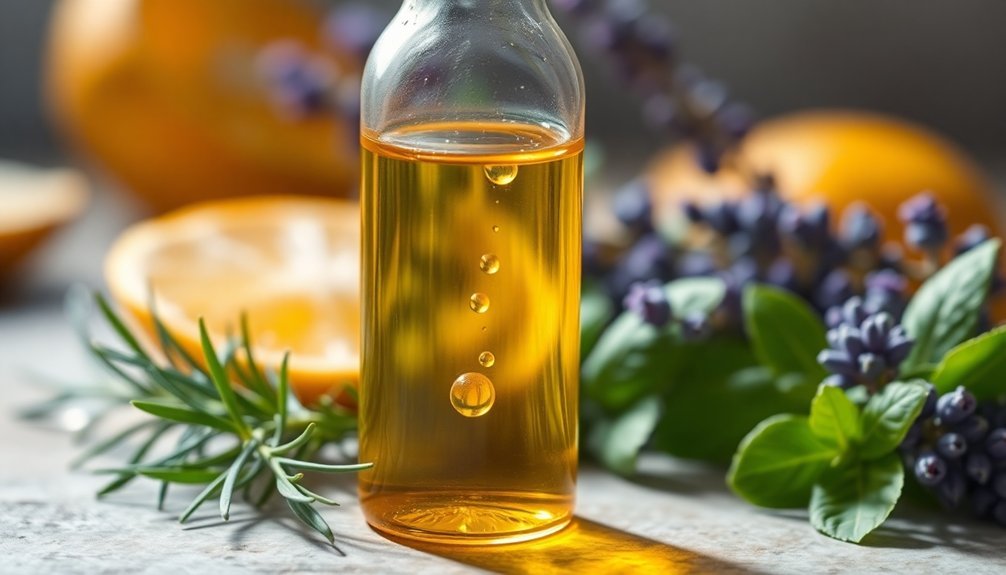
Vitamin E oil stands as one of nature's most powerful antioxidant preservatives, making it an ideal choice for extending the shelf life of homemade fragrances. When you add it to your fragrance blends, it actively scavenges free radicals that could otherwise degrade your essential oils and other natural ingredients.
You'll find that it works by donating electrons to stabilize these harmful compounds, effectively preventing oxidation.
You can source vitamin E from natural oils like wheat germ, sunflower, or safflower oil, or purchase it in concentrated form. For your homemade fragrances, you'll only need a small amount – just a few drops per ounce of your blend.
Beyond preservation, you'll get the added benefit of skin-nourishing properties, as vitamin E helps moisturize and protect your skin when you apply your fragrance.
Rosemary Extract for Extended Perfume Life
You'll find rosemary extract to be a powerful natural preservative, with its carnosic acid and phenolic diterpenes offering superior antioxidant protection for your homemade fragrances.
When storing your extract, keep it in a sealed, dark container at room temperature and use it within two months of opening to maintain its potency.
For ideal results in your fragrance formulations, blend the extract at 0.02% to 0.4% of your total formula while ensuring thorough incorporation with your essential oils.
Natural Antioxidant Properties
Among the most powerful natural preservatives available, rosemary extract stands out for its exceptional antioxidant properties in homemade fragrances.
You'll find its compounds, particularly carnosic acid, are more effective than Vitamin E in protecting your fragrance formulations. When you're creating perfumes, rosemary extract prevents oxidation and deterioration of essential oils while maintaining their fresh scent profiles.
- Contains powerful phenolic compounds like carnosic acid and rosmarinic acid
- Donates electrons to neutralize free radicals that degrade fragrances
- Prevents rancidity and extends the shelf life of your perfume oils
- Protects against UV-induced oxidative stress in fragrance compounds
- Maintains fragrance stability by inhibiting microbial growth and oxidation
These antioxidant properties make rosemary extract an ideal natural preservative for your homemade fragrances, ensuring they stay fresh and stable longer.
Extraction and Storage Methods
Proper extraction and storage of rosemary essential oil directly impacts your homemade fragrance's longevity. You'll get the best results using steam distillation, which yields up to 1.5% essential oil compared to hydro distillation's 0.44%. To maximize preservation, you'll need to time your extraction carefully – α-pinene peaks at 5 minutes, while camphor reaches its maximum at 15 minutes.
| Time Factor | Impact | Your Action |
|---|---|---|
| First 5 min | α-pinene peaks | Monitor closely |
| 15 min mark | Camphor peaks | Check composition |
| 30 min | Secondary compounds | Test aroma |
| 60 min | Diminishing returns | Assess quality |
| 100 min | Process complete | Store properly |
Store your extracted oil at 4°C in an airtight container after drying it with anhydrous sodium sulfate. This careful handling guarantees your fragrance maintains its aromatic profile and therapeutic properties longer.
Blending With Essential Oils
While creating natural fragrances, incorporating rosemary CO2 extract at 0.02-0.5% concentration serves as a powerful antioxidant shield for your essential oil blends.
You'll find it's particularly effective when working with pH levels below 8.5, helping to maintain the stability of your fragrance compounds without markedly altering their olfactory profiles. The extract's mild aroma won't interfere with your carefully crafted scent compositions.
- Add the extract directly to liquid formulations or dilute it with carrier oils
- Mix it into both Eau de Parfum and Eau de Toilette concentrations
- Store your finished blends properly to maximize the 18-month shelf life
- Keep pH levels under 8.5 for peak effectiveness
- Use within two months of opening to guarantee maximum antioxidant benefits
The extract's high phenolic content outperforms traditional mixed tocopherols, making it ideal for protecting your essential oil blends from oxidation.
Neem Oil's Protective Properties in Fragrance Making
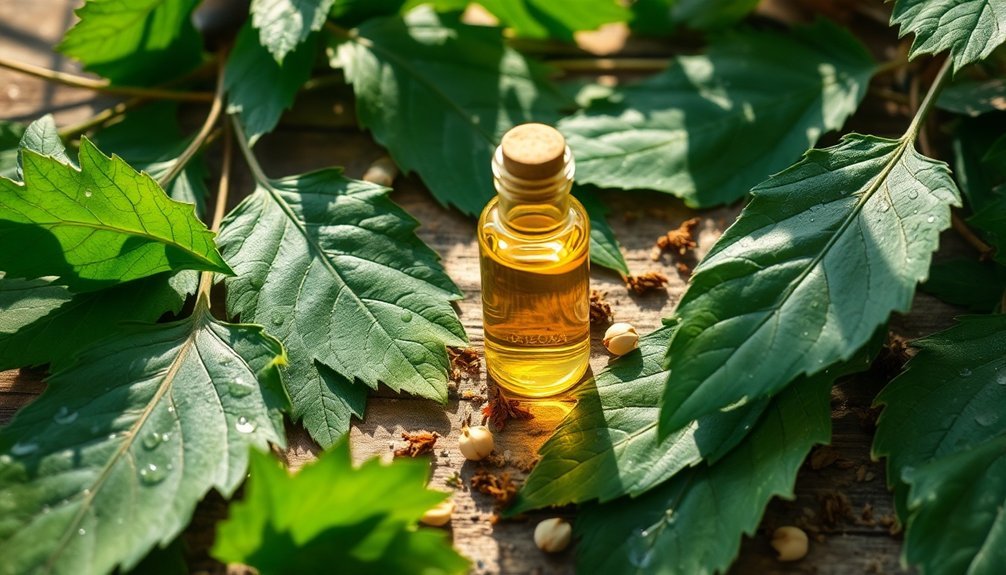
The remarkable protective properties of neem oil have made it a cornerstone ingredient in natural fragrance preservation. When you're creating homemade fragrances, you'll find that neem oil's antimicrobial properties help prevent bacterial and fungal growth, ensuring your blends stay fresh longer.
You can count on its natural insect-repelling abilities to protect your creations from pest infestations, especially in outdoor applications.
Neem oil's versatility shines through its ability to blend seamlessly with various fragrance notes while adding its own earthy undertones. You'll appreciate how it enriches your formulations with therapeutic benefits, including anti-inflammatory and antiseptic properties.
Whether you're making perfumes, soaps, or lotions, neem oil's moisturizing qualities will help your fragrances last longer on the skin while providing additional skincare benefits.
Grapefruit Seed Extract as a Natural Preservative
Among natural preservatives, grapefruit seed extract (GSE) stands out for its powerful antimicrobial properties in homemade fragrances.
You'll find it's rich in phytochemicals, including flavonoids and vitamins C and E, making it an excellent choice for protecting your fragrance formulations.
However, you can't rely on GSE alone as a preservative – it works best when combined with commercial preservatives at concentrations between 0.1% and 1.0%.
- Store GSE in a cool, dark place to maintain its 24+ month shelf life
- Use concentrations below 0.1% to avoid potential skin irritation
- Don't combine with anionic ingredients, as they'll reduce effectiveness
- Works well in water, alcohol, and oil-based fragrance formulations
- Test small batches first to determine compatibility with your specific ingredients
The Role of Raw Honey in Scent Preservation
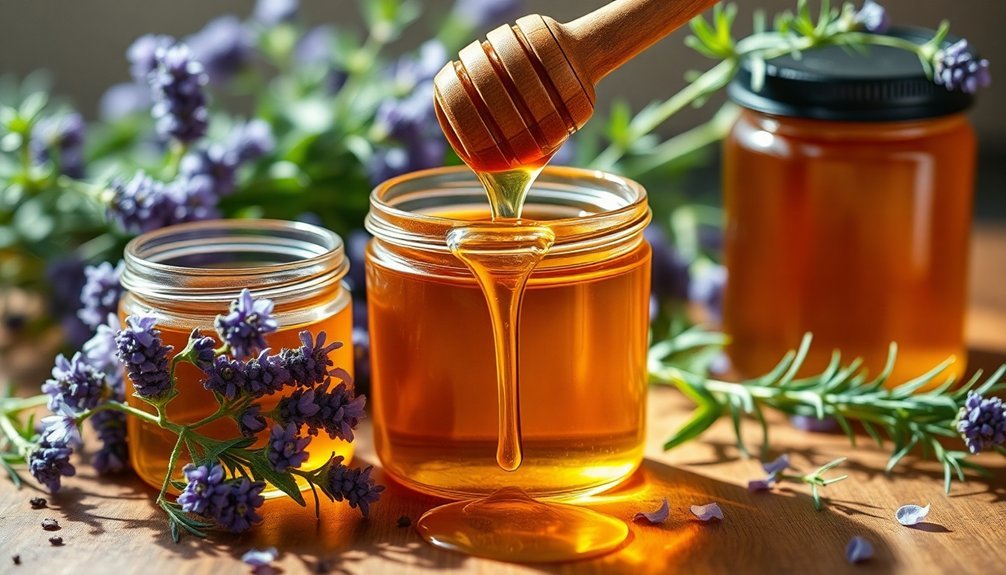
Raw honey's powerful antimicrobial properties make it an excellent natural preservative for your homemade fragrances, thanks to its low water content and ability to produce hydrogen peroxide.
You'll find that honey's natural acidity helps stabilize oil-based scents when properly emulsified, while its antioxidant properties protect against fragrance degradation.
When storing your honey-preserved fragrances, you can expect an extended shelf life due to honey's ability to prevent bacterial growth and maintain scent integrity through its multiple preservation mechanisms.
Antibacterial Properties Of Honey
While many natural preservatives exist, honey stands out as a remarkable antibacterial agent for homemade fragrances due to its complex defense mechanisms.
You'll find that honey's glucose oxidase enzyme converts sugar into hydrogen peroxide, creating a natural antimicrobial environment. Its high sugar content and low pH level work together to dehydrate harmful microorganisms, while polyphenols and defensin-1 provide additional protection against bacterial growth.
- Honey remains effective against both gram-positive and gram-negative bacteria
- Fresh honey requires only 10-18% concentration to inhibit bacterial growth
- You'll need higher concentrations of older honey, as its potency decreases over time
- Unlike simple sugar solutions, honey contains unique compounds that enhance preservation
- Its natural enzymes maintain fragrance integrity while preventing microbial contamination
Raw Honey Storage Benefits
Building on honey's antibacterial properties, proper storage techniques maximize its effectiveness as a natural fragrance preservative.
You'll want to keep your raw honey in airtight glass or food-grade plastic containers at room temperature, between 50°F and 70°F, to maintain its preservative qualities and prevent moisture absorption that could compromise your fragrances.
Honey-Oil Fragrance Stabilization
Natural honey plays an essential role in stabilizing fragrance blends when you're creating homemade scents. Its natural preservative properties help protect your oil-based fragrances from oxidation and rancidity.
You'll find that honey's low water content and acidic nature create an environment that inhibits the growth of bacteria, yeast, and mold. When working with honey in your fragrance formulations, keep the concentration around 2% to maintain stability without compromising the blend.
- Use a warm water bath between 95°F-110°F to decrystallize honey before blending
- Combine honey with naturally preservative oils like tea tree for enhanced stability
- Store your honey-oil blends in glass containers to prevent contamination
- Monitor the moisture content carefully, as honey can attract unwanted humidity
- Choose high-quality honey varieties based on their unique floral profiles to complement your fragrance blend
Essential Tea Tree Oil's Preservative Benefits
Tea tree oil stands as a powerful antimicrobial agent in natural fragrance preservation, primarily due to its active compound terpinen-4-ol.
You'll find it effectively fights various bacteria like E. coli and S. marcescens by disrupting their cell membranes and inhibiting cellular respiration.
While tea tree oil isn't strong enough to work as a standalone preservative in your DIY fragrances, it shines when combined with other preservatives.
You can reduce synthetic preservative concentrations up to 8.5 times by adding tea tree oil to your formulations. It works particularly well when paired with lavender oil and synthetic preservatives, meeting European Pharmacopoeia Commission standards.
For best results in your homemade fragrances, combine tea tree oil with other preservation methods rather than relying on it alone.
Witch Hazel: A Natural Fixative and Preservative
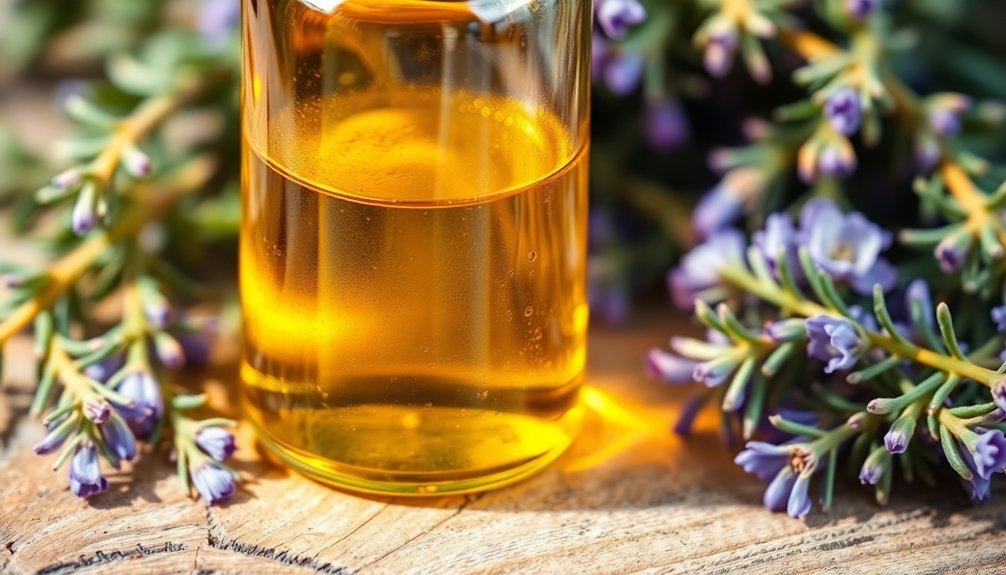
While witch hazel has gained popularity in natural skincare, its role in fragrance preservation comes with important limitations. Though it's often marketed as a preservative, it won't effectively prevent bacterial or yeast growth in water-based products.
However, you'll find it useful as a natural fixative due to its astringent properties and ability to create a protective barrier.
- Can be used at concentrations of 1-60%, depending on your formulation needs
- Works best when stored in cool, dry places with a shelf life up to 3 years
- Contains beneficial compounds like tannic acid, kaempferol, and quercetin
- Soluble in water, alcohol, and glycerol, but won't mix with oils
- Functions effectively as an antioxidant and anti-inflammatory agent
For ideal results in your homemade fragrances, combine witch hazel with other natural preservatives to enhance its protective qualities.
Benzoin Resin for Long-Lasting Natural Fragrances
Revered for centuries as a natural fixative, benzoin resin stands out as one of the most effective plant-based preservatives for homemade fragrances.
You'll find this aromatic substance extracted from the Styrax benzoin tree through careful incisions in its trunk, where the sap hardens into a resinous form.
When you're crafting natural perfumes, benzoin's warm, balsamic aroma won't just enhance your fragrance – it'll help extend its longevity by binding other scent ingredients together.
You can blend it seamlessly with essential oils like cardamom, frankincense, myrrh, and sandalwood.
Beyond its preservative properties, you'll benefit from its skin-protective qualities, as it forms an invisible film that helps lock in moisture while soothing irritation.
Just remember to dilute it properly and perform a patch test before use.
Frequently Asked Questions
Can Natural Preservatives Affect the Original Scent of My Perfume Blend?
Yes, natural preservatives can alter your perfume's original scent. They'll often add subtle notes since many, like rosemary and grapefruit seed extracts, have their own aromas. Consider using odorless options like Leucidal Liquid instead.
How Do Seasonal Temperature Changes Impact Plant-Based Preservative Effectiveness?
You don't need to worry about seasonal changes affecting your plant-based preservatives. They'll maintain their effectiveness in both hot and cold weather, as their antimicrobial properties remain stable across different temperatures throughout the year.
What's the Minimum Concentration of Natural Preservatives Needed for Fragrance Stability?
You'll need at least 0.8% natural preservatives for basic stability, but aim for 1.5-2% to guarantee reliable protection. Your specific concentration depends on the preservative type and formula's pH level.
Are There Plant-Based Preservatives That Shouldn't Be Mixed Together?
You shouldn't mix vitamin E with rosemary extract, as they're both antioxidants and won't enhance preservation. Also, avoid combining tea tree oil with grapefruit seed extract, as they can counteract each other's effectiveness.
How Can I Test if My Natural Preservatives Are Still Active?
You can test preservative activity by conducting pH tests, monitoring for changes in color or odor, and using at-home microbial test kits. Watch for signs of contamination like cloudiness, mold, or separation.
In Summary
You've now got a natural toolkit for creating long-lasting fragrances that won't compromise your commitment to plant-based ingredients. Whether you choose to work with glycerin, beeswax, or any of these preservatives, you'll find that your homemade scents can endure without synthetic additives. Start experimenting with these natural options, and you'll soon be crafting perfumes that stay fresh while staying true to nature.

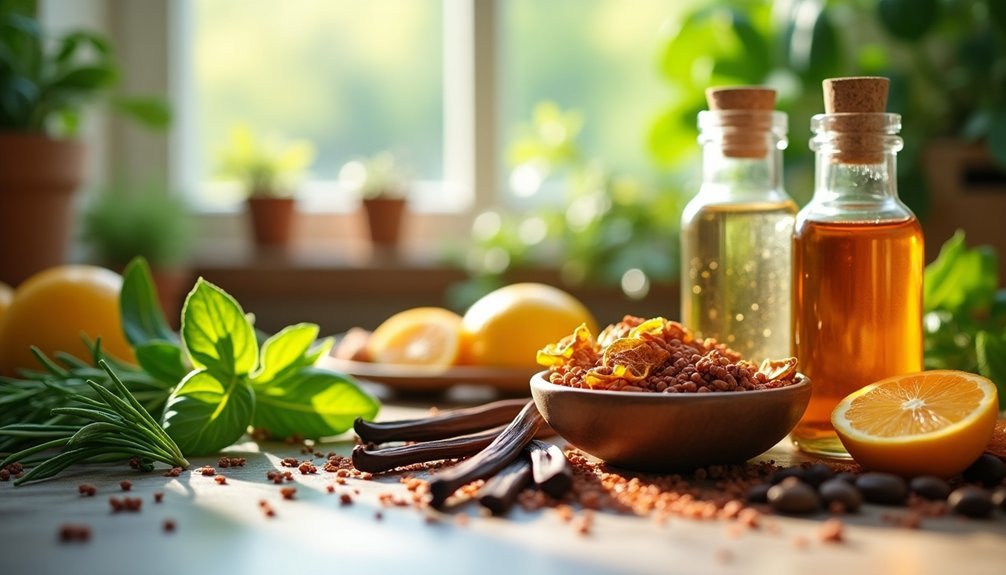



Leave a Reply